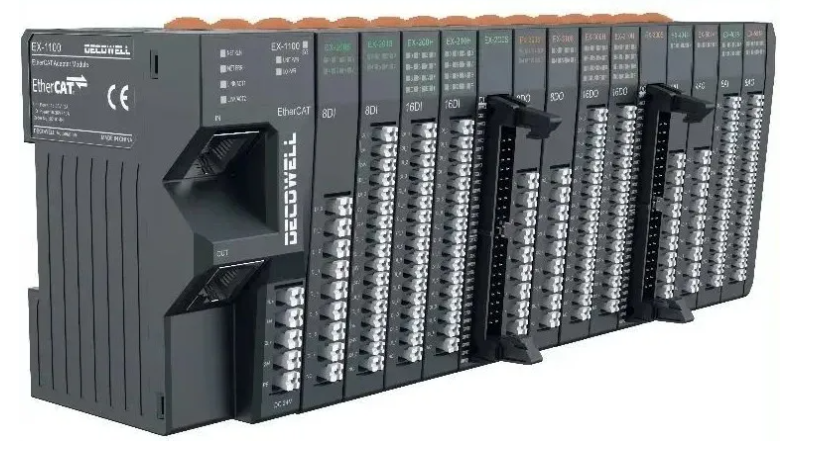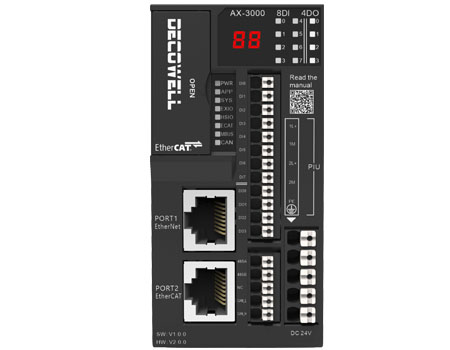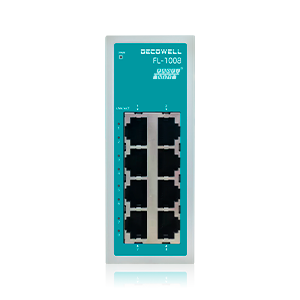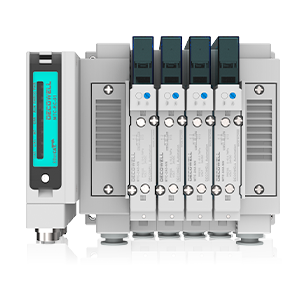
logistics industry
Application of Decowell remote I/O module in logistics sorting system
Logistics sorting system

The intelligent logistics conveying and sorting system is the core subsystem of material handling and warehousing. It is the key equipment for
executing functions such as commodity entry/exit, unpacking and picking, review and packaging, and path sorting. It runs through the entire
logistics process like an aorta.
With the rapid development of e-commerce, the operating efficiency, accuracy, stability, online rate, and processing capacity of conveying and
sorting systems and equipment are important factors that determine the operating efficiency, operating cost, operating quality, and user
satisfaction of warehouse distribution centers and modern logistics systems. Intelligence, modularization, and standardization have become
key factors and development trends that affect the performance of conveying and sorting systems and equipment.
01 Logistics sorting process
A logistics sorting system consists of a series of various types of conveyors, additional facilities, and control systems, which can be roughly
divided into four stages: confluence, sorting signal input, diversion, and distribution.
The intelligent automated sorting system includes a linear cross-belt sorting system, a circular cross-belt sorting system (single-layer single
car, double-layer single car, single-layer double car, etc.), and is equipped with an independently developed electronic control system and
information management system.
01 Merge
The materials picked from different cargo locations according to the picking instructions are sent to the pre-processing equipment in a certain
way and then collected on the main conveyor line by the pre-processing equipment. This process is called merge.
02 Sorting
The signal input arrives at the material on the main conveyor line, and the basic information of the material is read in by the automatic
identification device (such as a barcode scanner, etc.), and the computer processes the read material information accordingly. This process is
called sorting signal input.
03 Diversion
After the material information is read into the computer system, it continues to move on the main conveyor line. The storage shelf sorting
system detects the position of the material movement in real-time. When the material reaches the corresponding sorting crossing, the control
system sends a sorting instruction to the classification mechanism, and the classification mechanism immediately generates a corresponding
action to make the material enter the corresponding sorting crossing. This process is called diversion.
04 Distribution
The material entering the sorting crossing finally arrives at the terminal of the sorting system and is transported to the corresponding area by
manual or mechanical handling tools.
02 Module Application
Scheme 1:
The project uses Siemens S7-1200PLC, Decowell EX series Profinet, and Modbus-TCP adapter, and expands digital I/O modules to connect sensors
and actuators on site. Through PLC data collection and analysis, it can accurately and quickly sort packages on-site.

Application Highlights:
Using distributed remote I/O to replace a large number of manual sorting, reduce human resource investment, and greatly improve efficiency;
Low cost, good stability, short delivery cycle;

Scheme 2:
The project is mainly used in a large domestic logistics distribution center, and express delivery is carried out by conveying and sorting.
Siemens 1500 se ries PLC and Decowell single line 12 FS integrated I/O are used on site, which are applied to the conveyor line and rotary
machine on site.

Application highlights:
High response time requirements: able to unload goods in the shortest time and classify them according to the sending location;
High accuracy: these goods are delivered to the subcontracting points in the designated area through fully automatic conveyor lines;
Strong signal speed and stability: delivered to different regional distribution platforms according to the distribution location, and centralized
loading and distribution;
In addition, the new LS series discrete I/O that Decowell is about to release can also be well applied to the logistics industry.

The LS series is a distributed I/O module developed based on Decowell's self-developed bus WELLBUS. This series of modules uses the method
of signal superposition on the power supply to transmit signals and power supply at the same time, and can freely choose the topology structure.
In addition, the compact module structure provides customers with more design space, which can be applied to logistics warehousing and other
occasions with dispersed points and flexible layouts.
03 Device topology diagram
04 Features of Decowell remote I/O module

Features of EX series card-type I/O products:
1. Stable communication, fast response, convenient operation, and high efficiency;
2. Rich bus protocols, supporting multiple communication protocols, such as EtherCAT, PROFINET, DeviceNet, CC-Link, Ethernet/IP,
Modbus-RTU, CC-Link IEF Basic, etc.;
3. Rich signal types, which can meet factory automation and process automation control. Support digital quantity, analog quantity, temperature module, encoder module, and free communication module;
4. Compact structure, small module size, a single I/O module supports up to 32 digital signal points;
5. Strong expansion capability, a single adapter can expand up to 32 I/O modules, and the coupler scans quickly;
6. Simple and easy to use, standard DIN35 rail installation, plug-in terminals, and tool-free installation.

FS series integrated I/O product features:
FS series remote IO has the advantages of rich bus protocols, stable communication, compact structure, etc. It is widely used in the logistics industry, education industry, single-machine automation equipment robot workstations, etc. It supports mainstream industrial bus protocols EtherCAT, PROFINET, DeviceNET, CC-Link, CC-LinkIE Filed Basic, etc.






















